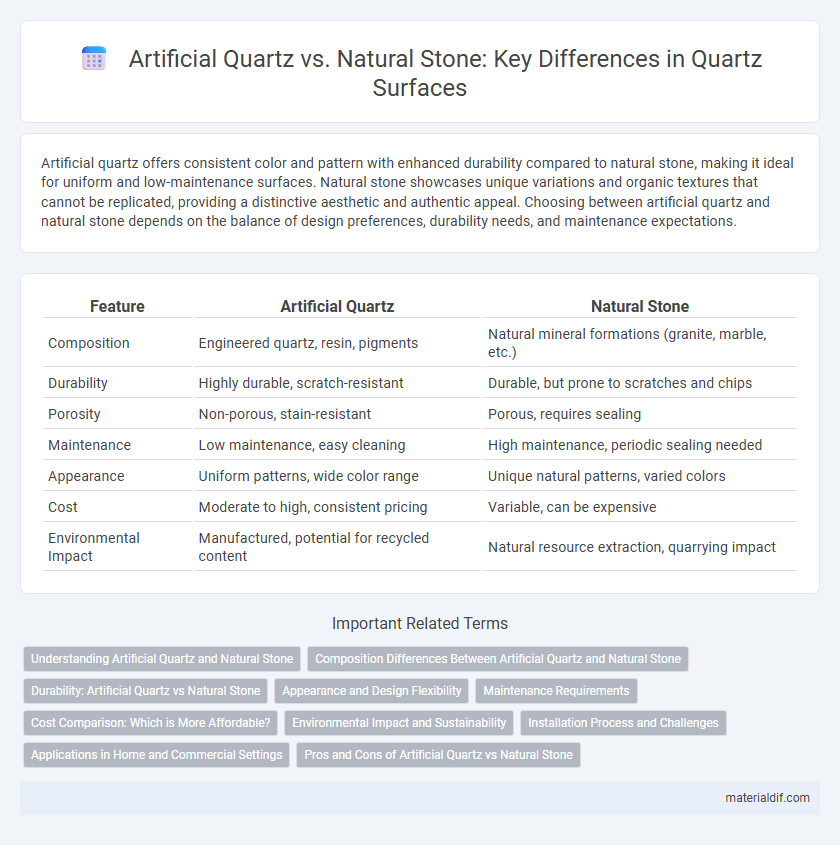Artificial quartz offers consistent color and pattern with enhanced durability compared to natural stone, making it ideal for uniform and low-maintenance surfaces. Natural stone showcases unique variations and organic textures that cannot be replicated, providing a distinctive aesthetic and authentic appeal. Choosing between artificial quartz and natural stone depends on the balance of design preferences, durability needs, and maintenance expectations.
Table of Comparison
| Feature | Artificial Quartz | Natural Stone |
|---|---|---|
| Composition | Engineered quartz, resin, pigments | Natural mineral formations (granite, marble, etc.) |
| Durability | Highly durable, scratch-resistant | Durable, but prone to scratches and chips |
| Porosity | Non-porous, stain-resistant | Porous, requires sealing |
| Maintenance | Low maintenance, easy cleaning | High maintenance, periodic sealing needed |
| Appearance | Uniform patterns, wide color range | Unique natural patterns, varied colors |
| Cost | Moderate to high, consistent pricing | Variable, can be expensive |
| Environmental Impact | Manufactured, potential for recycled content | Natural resource extraction, quarrying impact |
Understanding Artificial Quartz and Natural Stone
Artificial quartz consists of approximately 93% natural quartz combined with resins and pigments, resulting in a non-porous surface that offers greater stain resistance and durability compared to natural stone. Natural stone, such as granite or marble, is quarried directly from the earth, featuring unique patterns and natural porosity that require regular sealing to prevent damage. Understanding the composition and maintenance requirements of artificial quartz versus natural stone is crucial for selecting the ideal material for countertops and interior surfaces.
Composition Differences Between Artificial Quartz and Natural Stone
Artificial quartz is primarily composed of approximately 90% ground quartz particles combined with resins and pigments to create a uniform, non-porous surface. Natural stone, such as granite or marble, consists of varying mineral compositions like feldspar, mica, and quartz, formed through geological processes over millions of years. The resin binder in artificial quartz enhances durability and stain resistance, while natural stone's heterogeneous mineral matrix results in unique patterns and variable porosity.
Durability: Artificial Quartz vs Natural Stone
Artificial quartz exhibits superior durability compared to natural stone due to its engineered composition of approximately 90% quartz particles combined with resin and pigments, resulting in enhanced resistance to scratches, stains, and impact. Unlike natural stone, which is porous and prone to chipping or etching from acidic substances, artificial quartz offers non-porous surfaces that require less maintenance and provide consistent strength. This durability advantage makes artificial quartz a preferred choice for high-traffic countertops and flooring where longevity and resilience are critical.
Appearance and Design Flexibility
Artificial quartz offers a consistent appearance with uniform patterns and colors, providing extensive design flexibility for modern interiors. Natural stone displays unique veining and color variations, which add character but limit predictability in design outcomes. The engineered nature of artificial quartz allows customization in slabs, fitting specific design needs that natural stone cannot always match.
Maintenance Requirements
Artificial quartz requires minimal maintenance compared to natural stone, as its non-porous surface resists stains, scratches, and bacteria without the need for sealing. Natural stone demands regular sealing and careful cleaning to prevent damage from moisture and acidic substances. This low-maintenance quality makes artificial quartz a popular choice for durable, hygienic countertops in busy kitchens and bathrooms.
Cost Comparison: Which is More Affordable?
Artificial quartz typically costs between $50 and $150 per square foot, offering a more budget-friendly option compared to natural stone, which ranges from $60 to $250 per square foot depending on the type and rarity. Quartz slabs provide consistent quality and lower maintenance expenses, reducing long-term costs often associated with natural stone like granite or marble. Installation for artificial quartz tends to be more straightforward, minimizing labor charges compared to the specialized handling required for natural stone surfaces.
Environmental Impact and Sustainability
Artificial quartz offers a more sustainable alternative to natural stone by utilizing engineered manufacturing processes that reduce waste and optimize raw material use. Unlike natural stone quarrying, which disrupts ecosystems and depletes finite resources, artificial quartz production often incorporates recycled materials and eco-friendly resins. This results in a lower carbon footprint and less environmental degradation, making artificial quartz a preferred choice for environmentally conscious interior design and construction projects.
Installation Process and Challenges
Artificial quartz offers a more predictable and streamlined installation process compared to natural stone due to its engineered consistency in size and shape. The uniform thickness and density of quartz slabs reduce the risk of cracking and simplify cutting, while natural stone often requires extra care and adjustments to accommodate irregularities and fractures. Handling natural stone surfaces demands specialized skills to prevent damage during installation, whereas quartz installations benefit from standardized fabrication techniques that minimize on-site challenges.
Applications in Home and Commercial Settings
Artificial quartz offers superior durability and uniformity compared to natural stone, making it ideal for high-traffic commercial environments and busy home kitchens. Its non-porous surface resists stains and bacteria, enhancing hygiene in healthcare facilities and food service areas. Natural stone, prized for its unique veining and aesthetic appeal, is often favored in residential spaces where visual elegance and craftsmanship are primary considerations.
Pros and Cons of Artificial Quartz vs Natural Stone
Artificial quartz offers exceptional durability, low porosity, and consistent color patterns, making it resistant to stains and scratches compared to natural stone. Natural stone boasts organic beauty with unique veining and natural variations, but it requires regular sealing and maintenance due to higher porosity and susceptibility to damage. Cost-wise, artificial quartz is generally more affordable and easier to fabricate, while natural stone tends to be more expensive and varies in availability.
Artificial Quartz vs Natural Stone Infographic

 materialdif.com
materialdif.com